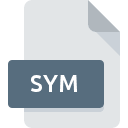.SYM File Extension

Symbols File
| Developer | N/A |
| Popularity | |
| Category | Developer Files |
| Format | .SYM |
| Cross Platform | Update Soon |
What is an SYM file?
.SYM files serve as repositories for symbolic information related to a program’s source code, such as function names, variable names, and line numbers. They are crucial for debugging and analyzing software behavior, especially in scenarios where only the compiled binary is available.
More Information.
Symbol files were primarily used in traditional desktop software development environments, where debugging tools relied on symbolic information to provide developers with insights into program execution flow and variable values during runtime.
Origin Of This File.
Symbol files have been integral to software development for decades, originating from the need to map compiled machine code back to its corresponding source code constructs for debugging and analysis purposes.
File Structure Technical Specification.
.SYM files typically contain structured data in a format specific to the toolchain or compiler used to generate them. They may include mappings between memory addresses and source code locations, function and variable names, as well as debugging directives and metadata.
How to Convert the File?
Windows:
- Use debugging tools like WinDbg or Visual Studio Debugger to open and analyze .SYM files.
- Alternatively, you can use third-party debuggers compatible with the debugging format generated by the compiler used to create the .SYM file.
Linux:
- Utilize debugging tools such as GDB (GNU Debugger) or LLDB (LLVM Debugger) to open and analyze .SYM files.
- These tools provide comprehensive debugging capabilities for software development on the Linux platform.
macOS:
- Use debugging tools like LLDB or Xcode’s debugger to open and analyze .SYM files on macOS.
- Xcode provides a comprehensive development environment for macOS and iOS applications, including debugging support for symbol files.
Android:
- For Android development, utilize debugging tools provided by the Android SDK, such as Android Studio’s debugger.
- Android Studio’s debugger supports the analysis of .SYM files generated during the compilation of Android applications.
iOS:
- In iOS development, use Xcode’s debugging capabilities to open and analyze .SYM files.
- Xcode is the primary development environment for iOS applications and provides robust debugging support, including the handling of symbol files.
Others:
- For platforms or development environments other than Windows, Linux, macOS, Android, or iOS, refer to the respective debugging tools and procedures tailored to those environments.
- Ensure compatibility between the debugger used and the debugging format generated by the compiler to open and analyze .SYM files effectively.
Advantages And Disadvantages.
Advantages:
- Facilitates easier debugging by providing symbolic representations of program elements.
- Enables more efficient analysis of compiled code without access to the original source.
- Integral for diagnosing and fixing software bugs in complex applications.
Disadvantages:
- Can increase the size of compiled binaries due to the inclusion of debugging information.
- May pose security risks if not handled properly, as symbol files can potentially expose sensitive information about a program’s internal structure.
How to Open SYM?
Open In Windows
.SYM files can be opened in Windows using various debugging tools like WinDbg, Visual Studio Debugger, or third-party debuggers that support the debugging format generated by the compiler used to create the .SYM file.
Open In Linux
.SYM files can be accessed and analyzed using debugging tools such as GDB (GNU Debugger) or LLDB (LLVM Debugger).
Open In MAC
On macOS, debugging tools like LLDB or Xcode can be used to open and analyze .SYM files.
Open In Android
.SYM files can be utilized with debugging tools provided by the Android SDK, such as Android Studio’s debugger or third-party debugging solutions compatible with the Android platform.
Open In IOS
In iOS development, Xcode’s debugging capabilities support the analysis of .SYM files generated during the compilation of iOS applications.
Open in Others
Other platforms and development environments may have their own debugging tools and procedures for working with .SYM files, typically tailored to the specific toolchain and compiler used in the development process.













